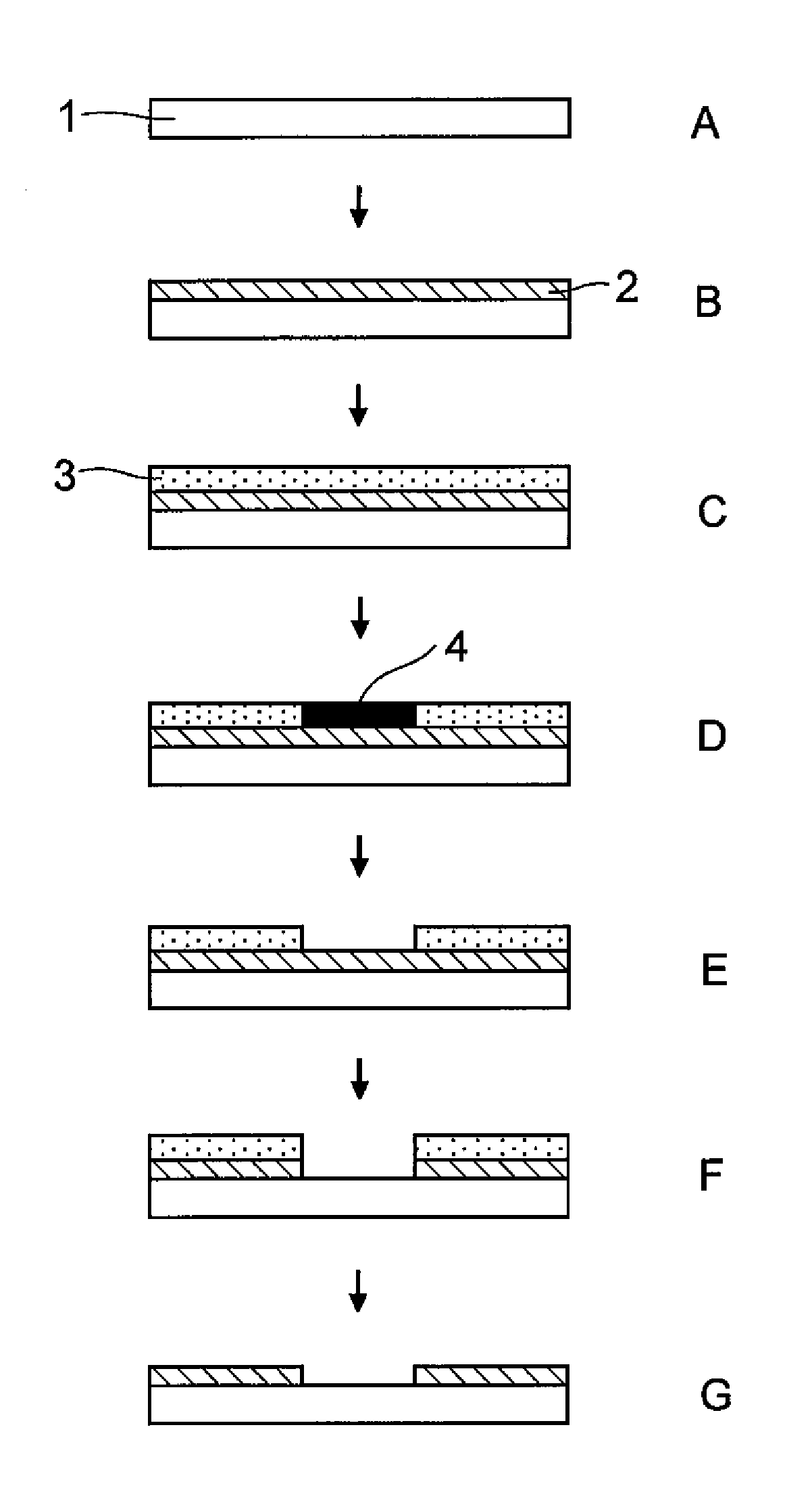Etching liquid for conductive polymer, and method for patterning conductive polymer
a technology of etching liquid and conductive polymer, which is applied in the direction of printed circuit manufacturing, printed circuit aspects, chemistry apparatus and processes, etc., can solve the problems of difficult to make conductive polymers into ink, conductive polymers are prone to aggregation, and the peripheral area of liquid droplets becomes thicker than the central area, and achieve excellent etching capability
- Summary
- Abstract
- Description
- Claims
- Application Information
AI Technical Summary
Benefits of technology
Problems solved by technology
Method used
Image
Examples
example 1-1
[0113]A test substrate (B) was prepared by forming on the surface of a polyethylene terephthalate (PET) sheet a thin film of about 50 nm using as a conductive polymer BAYTRON F E (trade name, manufactured by Starck, containing poly(3,4-ethylenedioxythiophene)).
[0114]A dry film resist, product name ORDYL LF525 (manufactured by Tokyo Ohka Kogyo Co., Ltd.) was affixed to the test substrate (B) using a laminator, thus giving a test substrate (C). The test substrate (C) to which the dry film resist was affixed was exposed to UV rays while being held in close contact with a master pattern using a frame-type vacuum exposure unit, thus giving a test substrate (D). The exposed test substrate (D) was developed by spraying at a spray pressure of 1 MPa using a 1% Na2CO3 aqueous solution as a developer while regulating the temperature at 30° C., thus giving a test substrate (E).
[0115]The developed test substrate (E) was washed with water and immersed in a 20% concentration aqueous solution of (N...
examples 1-2 to 1-5
and Comparative Example 1-1
[0120]An etching treatment was carried out in the same manner as in Example 1-1 except that the concentration of the aqueous solution of (NH4)2Ce(NO3)6 was changed to 10% for Example 1-2, 5% for Example 1-3, 2% for Example 1-4, 1% for Example 1-5, and 0.5% for Comparative Example 1-1, and these results are given in Table 3. The surface of the conductive polymer covered by the dry film resist showed no change due to etching. Furthermore, there was no change in the substrate due to etching.
TABLE 3(NH4)2Ce(NO3)6(%)Time required for etchingExample 1-120ExcellentExample 1-210ExcellentExample 1-35ExcellentExample 1-42GoodExample 1-51FairComp. Ex. 1-10.5Poor
Criteria for Time Required for Etching
[0121]With regard to the criteria for the time required for etching in Table 3 to Table 7, the time taken from starting etching until attaining a state in which there was no etching residue of conductive polymer in the section from which the dry film resist had been remove...
example 1-6
[0122]Using 100 g of an etching liquid containing 10.0% of (NH4)2Ce(NO3)6 and 1.0% of HNO3, evaluation of the time required for etching was carried out using the etching liquid immediately after being prepared by the same method as in Example 1-1. Furthermore, the etching liquid was allowed to stand for 72 hours while maintaining the liquid temperature at 30° C., and the presence or absence of a precipitate from the etching liquid after standing for 72 hours was checked visually. The results are given in Table 4.
[0123]When the same treatment as in Example 1-1 was carried out using this etching liquid after 72 hours, etching of a conductive polymer was possible.
[0124]The surface of the conductive polymer covered by the dry film resist showed no change due to etching. Furthermore, there was no change in the substrate due to etching.
PUM
| Property | Measurement | Unit |
|---|---|---|
| Temperature | aaaaa | aaaaa |
| Temperature | aaaaa | aaaaa |
| Temperature | aaaaa | aaaaa |
Abstract
Description
Claims
Application Information
 Login to View More
Login to View More - R&D
- Intellectual Property
- Life Sciences
- Materials
- Tech Scout
- Unparalleled Data Quality
- Higher Quality Content
- 60% Fewer Hallucinations
Browse by: Latest US Patents, China's latest patents, Technical Efficacy Thesaurus, Application Domain, Technology Topic, Popular Technical Reports.
© 2025 PatSnap. All rights reserved.Legal|Privacy policy|Modern Slavery Act Transparency Statement|Sitemap|About US| Contact US: help@patsnap.com


